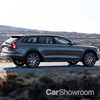Volvo has outed their latest model to be branded under the Cross Country moniker, this time based upon their newest flagship 90 Series wagon and called, naturally, the V90 Cross Country. But far from being an all-wheel driven, higher-riding version of that estate, Volvo says that a much more thorough list of changes went into its development over any of its forerunners.
“The V90 Cross Country takes the elegance of the V90 and transforms it into an all-road car that delivers safety, comfort and performance in a capable and adventurous package,” said Håkan Samuelsson, President & CEO, Volvo Car Group.
The most notable change over the V90 is, of course, the Cross Country’s added height as well as the ruggedised cladding over the wheel arches, front/rear bumpers, and side sills. The car sits 65mm taller over the ground, with a wider footprint of 20mm at the front and 40mm at the rear. Additionally, Volvo has also tweaked the overhangs and bumper shape to improve the Cross Country’s departure angle for better off-road chops.
Volvo has yet to confirm the full line-up of powertrains that will the car will be released with. However, we have little reason to expect it to differ much from the standard V90 estate’s combination of 2.0-litre turbocharged petrol and diesel motors to deliver power to its permanent four-wheel drive system.
Volvo has been testing the new V90 Cross Country in the frozen north of its home country of Sweden as well as in Arizona’s arid and unforgiving desert heat. There, the car’s advanced driving modes were calibrated. The car will come with Comfort, Eco, Dynamic, but also a Rough Road setting.
With All-Wheel Drive, increased ride height, and a chassis optimised for comfort and control in all weather and road conditions, the new V90 Cross Country takes our versatile V90 estate and adds the heart of an explorer,” said Dr Peter Mertens, Senior Vice President Research & Development at Volvo Cars.
Volvo plans to start production of the all-new V90 Cross Country presently at their Torslanda factory, with customer deliveries expected to commence at the end of 2016 in selected markets. Australian units will arrive in the first half of 2017.
For more on Volvo vehicles, including pricing and specifications, check out our Showroom.




























